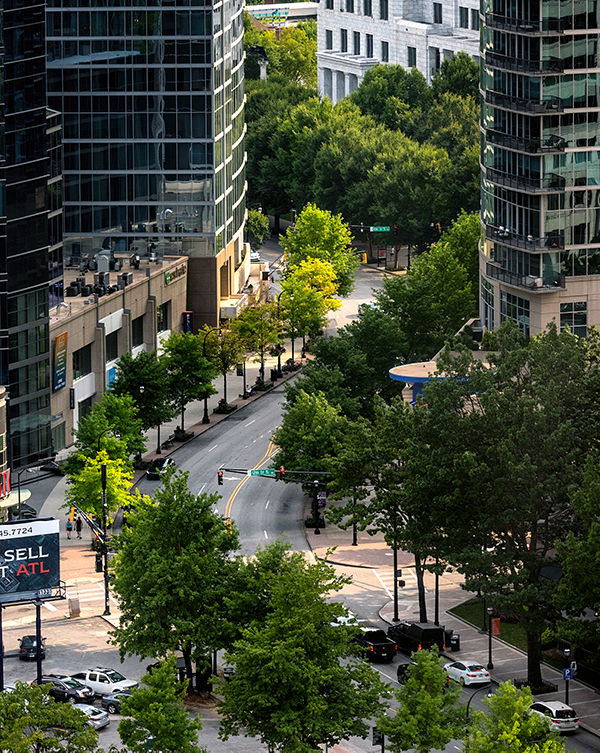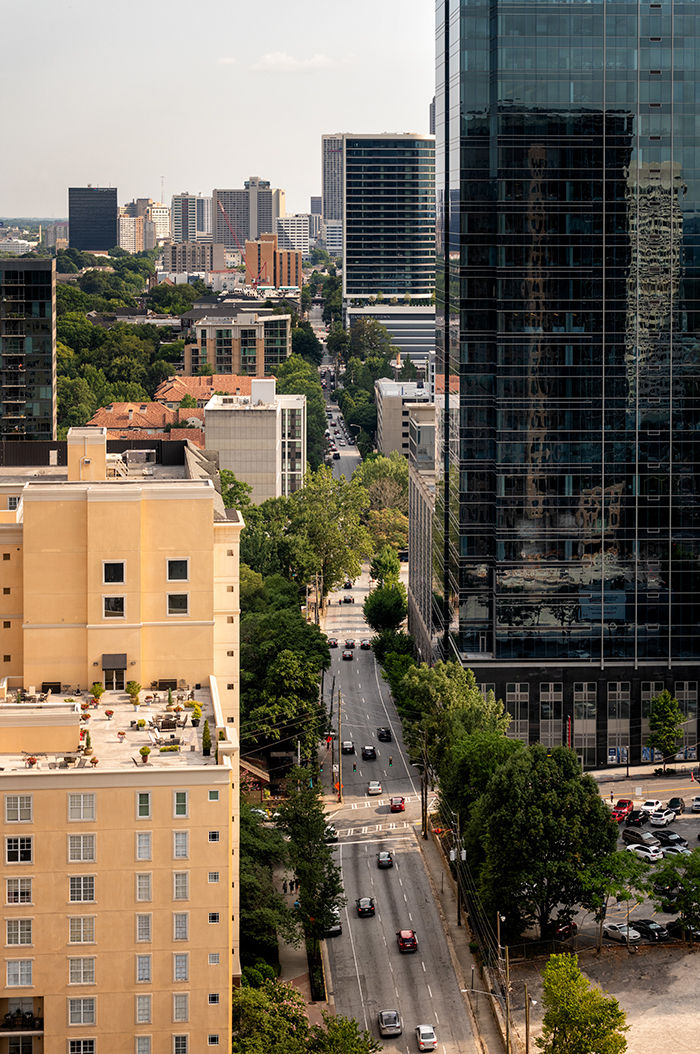Midtown Alliance’s Tree Management Program Helps Keep Over 2,500 Trees Healthy
Published: 08/01/19

From Oaks to Elms and Cypresses, Midtown’s lush canopy of trees is an integral part of the district’s walkable environment. But many residents, workers, and visitors in the district likely don’t know there is a dedicated team of caretakers working year-round to ensure that Midtown’s trees remain healthy.
There are more than 2,500 trees in the Midtown Improvement District’s right-of-way, and about 1,000 of these have been added within just the past five years. Many are initially planted by private developers in order to ensure their projects are up to code, and the most recent development boom has resulted in the addition of lots of new trees in place of former barren surface parking lots.
But landscape contractors typically only offer one-year warranties on trees, and after that the trees are cared for by Midtown Alliance’s Green team.
“Trees are not only beautiful, but they contribute to the health of our public realm, and we want them to continue to thrive,” said Cladie Washburn, landscape architect and Midtown Alliance director of capital projects. “I think you’d be hard pressed to find a peer city with a tree program this robust.”

Creating a Healthy Urban Canopy
It’s not easy being green. In fact, urban trees face many challenges: small legacy tree wells that constrain growth, drivers who hit them, car and bus exhaust, a limited growing area and even damage from dog urine.
But the extra effort pays off, as trees help clean the district’s air, provide shade and reduce the heat island effect. According to a recent University of Wisconsin study, trees can lower summer daytime temperatures by 10 degrees Fahrenheit. This is important given a recent Georgia Public Broadcasting story examining climate change that states Atlanta today experiences an average of 22 more days when the mercury reached 90F than the city did in 1970.
“Urban tree care presents another level of challenges in addition to the usual environmental factors that affect tree health. Restricted root zones, lack of access to irrigation, and compacted and often poor soil conditions, lend challenges to keeping trees healthy and growing vigorously. Midtown Alliance’s tree care program plays an essential role in protecting and maintaining one of Midtown’s greatest assets.” Midtown Green Program Manager Kyle Guess.
When walking through Midtown, you might notice that each street tends to consistently feature only one or two types of trees. That is due to the district’s Streetscape Plan, which dictates what type of canopy or understory tree species should be planted along each corridor, which makes them easier to care for and helps ensure they will thrive in the urban environment. Experts and members of the community helped establish these guidelines in the original Blueprint Midtown planning effort.
“When we have the same type of tree on one block, it’s more predictable to take care of them,” Washburn said. “If they’re planted around the same time, they grow the same way, their leaves drop around the same time, they can be pruned around the same time and they have a consistent aesthetic. They look like they belong together.”
The district’s tallest trees rise along Peachtree Street, where the program began with the planting of Willow Oaks and Nuttall Oaks that have matured to provide shade above signage level.

Midtown Green’s Role: Plant, Prune, Treat, Repeat
Although Midtown Green often works behind the scenes, its team members play a huge role on the ground every day in keeping the district clean and beautiful for everyone to enjoy. Daily tree care includes removal of broken limbs and fallen branches; spotting and reporting damage and other tree health issues; light pruning to ensure clearance for pedestrians, traffic signals and stop signs; watering newly planted trees for the first growing season; and removal of tons of leaf litter each fall.
Midtown Alliance’s annual tree management schedule includes:
- Planting: Between mid-October and mid-March, Midtown Alliance identifies diseased, dying and missing street trees and replaces them with healthy, urban-tolerant trees. This is often paid for partially or entirely by private developers to help ensure their projects satisfy the number of caliper inches of trees required for their Midtown project.
- Pruning: During dormant season, when the trees don’t have leaves, Midtown Alliance identifies corridors of trees that need pruning to enhance public safety and help ensure healthy structure, growth and long-term viability. Earlier this year, Lacebark Elms were pruned along West Peachtree from Ponce De Leon Avenue to 18th Street and 14th Street between Williams and Barnes Streets. 66 Nuttall Oaks were also pruned on Peachtree, and 93 American Elms were trimmed throughout the District.
- Fertilizing: Each of the over 2,500 street trees that Midtown Alliance cares for are fertilized once every three years. That averages to about 850 trees, or 8,500 caliper inches, fertilized every year by injecting slow release nutrients into the root zones. Additionally, several times a year, Midtown Green identifies specific problem areas, where it aerates and fertilizes trees in an effort to bring them back to health.
A consulting arborist also inspects each tree in the district once a quarter, and Midtown Alliance also works with an arborist for special assignments.
The organization’s tree management budget includes the cost to replace trees that have been damaged beyond repair. Of the total inventory Midtown Green plants, about 10 to 15 percent do not make it due to damage, a benchmark which actually means the program is successful in a bustling urban environment.
“When our trees are doing great, you can see the vigor, you can see that they’re super green and super lush,” Washburn said. “That’s not by accident.”
Check out Midtown’s Streetscape Plan here.
If you see a damaged street tree in the Midtown Improvement District’s right-of-way, please notify Midtown Alliance by emailing info@midtownatl.com.